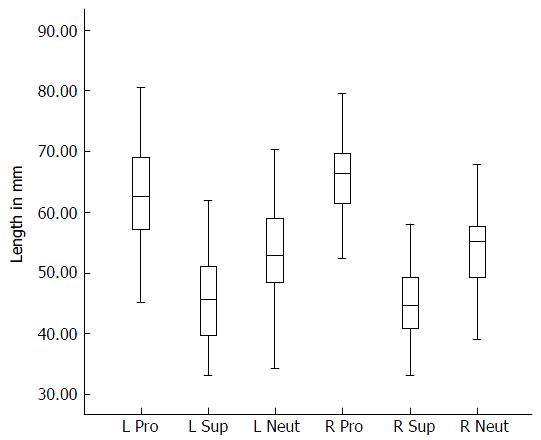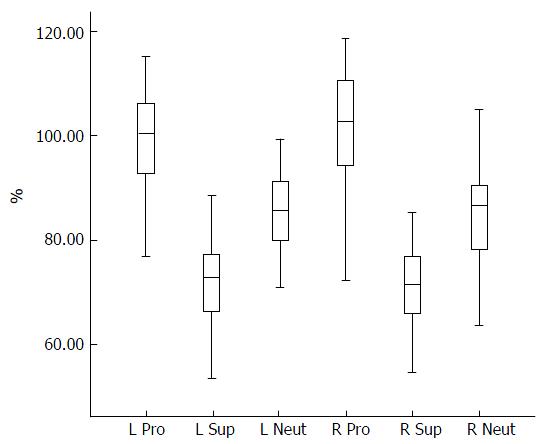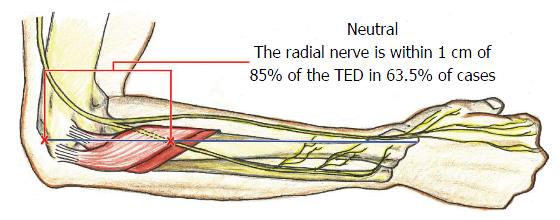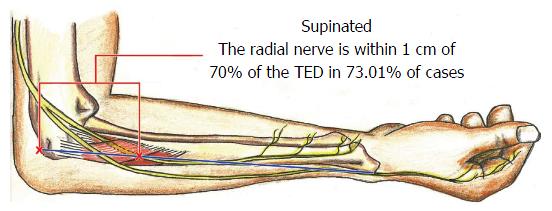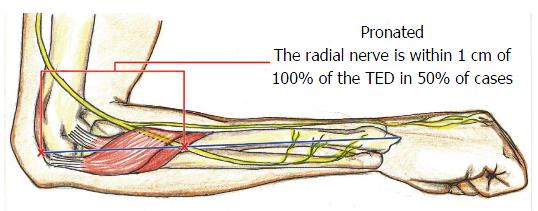Copyright
©The Author(s) 2017.
World J Orthop. Apr 18, 2017; 8(4): 310-316
Published online Apr 18, 2017. doi: 10.5312/wjo.v8.i4.310
Published online Apr 18, 2017. doi: 10.5312/wjo.v8.i4.310
Figure 1 Boxplots of the distance from the humeral epicondyle to the midpoint of the radial nerve (mm) for the left and right forearm in pronated, supinated and neutral positions.
Cross bars represent the median value for each group, while the boxes show the 50% confidence interval and the whiskers extend to the highest and lowest values. L: left; R: Right; Pro: Pronated; Sup: Supinated; Neut: Neutral.
Figure 2 Boxplots of the distance from the humeral epicondyle to the midpoint of the radial nerve (mm) for the left and right forearm in pronated, supinated and neutral positions as expressed as a percentage of transepicondylar distance breadth.
Crossbars represent the median value for each group, while the boxes show the 50% confidence interval and the whiskers extend to the highest and lowest values. L: left; R: Right; Pro: Pronated; Sup: Supinated; Neut: Neutral.
Figure 3 Boxplots of the distance from the proximal to the distal intersection of the radial nerve and the guide string for the left and right forearm in pronated, supinated and neutral positions.
Crossbars represent the median value for each group, while the boxes show the 50% confidence interval and the whiskers extend to the highest and lowest values. L: left; R: Right; Pro: Pronated; Sup: Supinated; Neut: Neutral.
Figure 4 Pictoral depiction of the location of the posterior interosseous nerve, along the longitudinal line drawn from the lateral epicondyle to the radial styloid, at 85% transepicondylar distance, with the forearm in neutral rotation.
TED: Transepicondylar distance.
Figure 5 Pictoral depiction of the location of the posterior interosseous nerve, along the longitudinal line drawn from the lateral epicondyle to the radial styloid, at 70 transepicondylar distance, with the forearm in supination.
TED: Transepicondylar distance.
Figure 6 Pictoral depiction of the location of the posterior interosseous nerve, along the longitudinal line drawn from the lateral epicondyle to the radial styloid, at 100% transepicondylar distance, with the forearm in pronation.
TED: Transepicondylar distance.
- Citation: Kamineni S, Norgren CR, Davidson EM, Kamineni EP, Deane AS. Posterior interosseous nerve localization within the proximal forearm - a patient normalized parameter. World J Orthop 2017; 8(4): 310-316
- URL: https://www.wjgnet.com/2218-5836/full/v8/i4/310.htm
- DOI: https://dx.doi.org/10.5312/wjo.v8.i4.310









